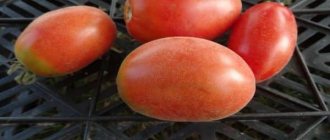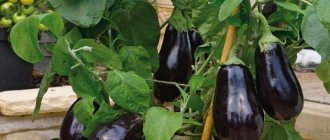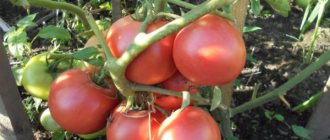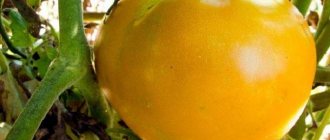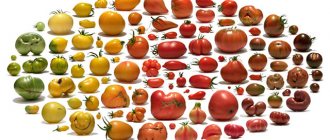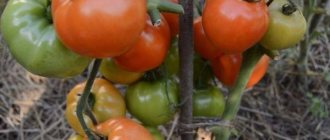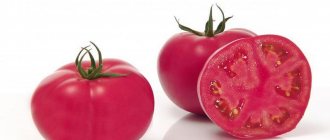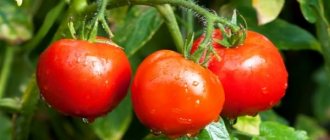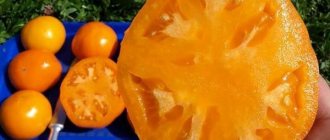There are probably no farmers who do not plant the Minusinsky exhibition tomato. There are many varieties in the group, where everyone will find tomatoes to suit their taste and preferences. The constant advantages were productivity, excellent product and taste qualities.
| Height | Landing location | Ripening time | Fruit color | Fruit size | Origin | Fruit shape |
| Tall | Greenhouse, Open ground | Mid-season | Reds | Large | Variety | Flat-round |
Minusinsk varieties of tomatoes: basic information
Minusinsk varieties of tomatoes: basic information
Tomato is an annual or perennial herbaceous vegetable crop from the nightshade family. At the moment, there are more than a thousand varieties. Tomatoes are very common in gardens and plots. Nowadays it is very difficult to imagine a garden that does not have tomato bushes. Often, gardeners and gardeners organize competitions. These competitions compare the quality of the fruit and its taste. You can consider yourself a real gardener if every year you get a good harvest and quality fruits.
Features of cultivation, planting and care
Sowing seeds of this tomato variety for seedlings is carried out 60-65 days before the intended planting in the ground. Seedlings dive at the stage of appearance of the second true leaf. When planting seedlings in a permanent place per 1 sq. m area we recommend placing up to 3 plants, when forming into 1 stem - up to 4.
Further care for tomatoes consists of timely watering, weed removal, pinching, fertilizing with complex mineral fertilizer and preventive measures to protect the crop from diseases and pests.
If you grew Orange Glass tomatoes from Minusinsk, please write in the comments whether you liked them or not. What was the yield and taste of the fruits like under your climatic conditions? How do you assess a variety's resistance to diseases and pests? If possible, attach a photo of the entire bush or individual fruits you grew to your comment. Thank you!
Your reviews of the Minusinsk orange glasses tomato, as well as additions to the description, will help many gardeners evaluate this variety more objectively and decide whether it is worth planting or not.
Minusinsk varieties of tomatoes: briefly about real representatives
Minusinsk varieties of tomatoes: briefly about real representatives
In the Krasnoyarsk region there is the city of Minusinsk, where every year they hold a holiday - “Minusinsk tomato”. These are annual folk festivals, and every year they hold a fair in honor of tomatoes. The tomatoes sold at this fair are grown on local plots. There is a competition at the fair. The contestants' task is to grow the largest tomato in a year and present it to the jury members. The main prize in this competition can be a car.
Features of cultivation
The Minusinsk glass tomato variety is grown only through seedlings. For a heated greenhouse, seeds are sown from February 20 to March 10. The seeds are collected independently. Before sowing, they are disinfected and treated with growth stimulants, giving a strong impetus for the development of powerful large-fruited plants.
For the primary substrate prepare:
- garden soil;
- humus;
- peat or rotted sawdust in the same proportion;
- if the soil is heavy and dense, take part of the river sand;
- add 500 ml of wood ash per 10 liters of substrate;
- the soil is also disinfected with various fungicides - trichodermin, phytosporin, foundationazole and others.
Treated seeds of the Minusinskie glasses variety are placed at a depth of 0.8-1 cm and sprinkled with loose soil. The container is covered with film and placed in a comfortable place with a temperature of at least 20 °C. From good, strong seeds, shoots appear in 5-10 days.
Tomato Minusinsky: about the leading varieties
Tomato Minusinsky: about the leading varieties
Let's talk a little about the winners. At the competition in two thousand and sixteen, the Sprint Timer variety won, the weight of one fruit was one thousand eight hundred seventy-eight grams. The winning competitor in two thousand and fourteen was called pink honey, its weight was three hundred grams less than one thousand five hundred and six grams. However, the most memorable winner was the record set in two thousand and eleven; in this year the contestant grew a tomato that weighed two kilograms and one hundred and forty-six grams. The eleventh year's record has still not been beaten.
Impetus for the development of tomato growing
Plant growing, including tomato growing, received an impetus for development with the appearance of exiled agronomist I.P. in the Minusinsk District in 1909. Hip.
Ivan Prokhorovich Bedro turned out to be a very active person and an excellent specialist. A year later, he founded the Minusinsk Agricultural Society, the surviving reports on the work of which are directly related to the topic of this article.
Miracle vegetable
But let's return to our days. Due to the growing popularity of Minusinsk tomatoes, articles like this one appear on the Internet:
Or this one.
Basically, everything written here is true, but...just imagine a tomato with the given dimensions: “...Starukhin grew a tomato weighing seven hundred and forty-five and a half grams. The diameter of this vegetable was forty-three centimeters ...” Get more soccer ball! And this clearly erroneous information migrates from site to site.
Exhibitions of melon growing and gardening
To find out the truth, let’s turn to the primary sources, namely the reports mentioned above: “Report of the Minusinsk Agricultural Society for 1912”, “Report of the Minusinsk Agricultural Society on the organization of the Second Exhibition of Melon Growing and Horticulture on August 29 and 30, 1913 in the city. Minusinsk."
The originals of these books are kept in the Minusinsk Museum of Local Lore. N.M. Martyanova.
So, Starukhin I.S. participated in both exhibitions. At the 1912 exhibition, he presented the variety he had bred, for which he received a bronze medal.
At the next exhibition in 1913, 6 varieties of tomatoes were presented by 16 exhibitors. And among them is the Starukhin variety. Ivan Savelyevich presented the jury with seven large tomatoes weighing from 132 to 180 spools. The spool contains 4.26 g. Consider that the almost round-shaped fruits of his name variety weighed from 562.3 g to 766.8 g.
Starukhin's tomatoes
A photograph of these tomatoes has been preserved.
Well, where is the giant tomato with a diameter of 43 cm? The truth is that there really was such a tomato (probably the one on the left), but only 43 cm in circumference!
The breeder was awarded a prize of 10 rubles. Then you could buy a cow with this money.
Rules for planting and care
To grow tomatoes in an unheated greenhouse, seeds are sown in the third ten days of February or the first ten days of March. For open ground, sowing of seedlings is done in late March - early April.
Planted tomatoes need care - watering, fertilizing, mulching the soil, removing weeds, protecting against diseases and pests. Immediately after planting, the stems are tied to a trellis using synthetic materials that do not cause rotting.
During the ripening of the crop, it is necessary to pay attention to fertilizing. For long-term fruiting of indeterminate varieties, which include, according to the description and photo, the Minusinskie Glasses tomato variety, the main stem is lowered from the support.
Sowing seeds for seedlings
Before sowing, it is advisable to sort the seeds by density in a 3% salt solution (1 tbsp per 1 liter of water). Then rinse in running water and soak for 20 minutes in a 1% solution of potassium permanganate, wash again.
Soil for sowing is prepared from turf soil, humus and peat mixed in equal proportions. To make the substrate light, add river sand (1/5 of the total volume) and a handful of wood ash. The soil mixture is steamed or calcined for disinfection, and spilled with a fungicide solution (Fitosporin, Fundazol, Trichodermin, etc.).
The procedure for sowing seeds and growing seedlings:
- The seeds are laid out in a row at a distance of 1 cm or planted in separate glasses.
- A layer of soil 0.5-1 cm thick is poured on top and the crops are covered with film.
- Place in a warm place with a temperature of +24 °C.
- Sprouted seeds should sprout on day 3, and unsprouted seeds on day 5-6.
- The seedlings are freed from shelter and placed on a bright windowsill or under additional lighting lamps.
- The temperature is lowered to 16 °C for 5 days, then raised again to +20-22 °C.
- Moisten the soil as it dries.
- Seedlings from a common container or cassette are planted into separate containers, in the phase of two true leaves.
Approximately 3 weeks after the first picking, when the roots of the seedlings completely fill the volume of the containers, a second transplant is carried out into larger containers. To prevent the development of root rot, a tablet of biological fungicide is placed in each container.
Transplanting seedlings
When the seedlings have 8 true leaves, 60 days after sowing they can be transplanted to a permanent place. By this time the soil and air should warm up to +18 °C.
The seedlings are transplanted with a ball of earth, watered and mulched the soil around the bushes with peat, straw or mown grass. As mulch after watering, you can use humus in an equal mixture with turf soil and a handful of ash.
Tomato care
According to reviews and photos, many factors influence getting a good harvest of the Minusinsk glasses tomato variety:
- temperature;
- soil and air humidity;
- feeding;
- formation of bushes.
First of all, it is necessary to remove the stepsons.
Without pinching, tomatoes can grow greatly. New shoots grow from the axil of each leaf to the detriment of fruit formation. Indeterminate varieties, which include Minusinsk glass tomatoes, have unlimited growth; they are formed into one stem, removing all the stepsons, and tied to a trellis.
Tomato requires constant moisture in the root layer of soil. The need for watering increases during flowering, fruit set and formation. The bushes are watered 2-3 times a week at the same time. Irrigation rate is from 5 to 15 liters per 1 sq. m.
Nitrogen and phosphorus fertilizers are required to set flower buds. The lack of these elements leads to the formation of weak flowers and the absence of ovaries. Regular watering will contribute to good plant nutrition. Once every 2 weeks it is useful to apply a complete complex fertilizer consisting of:
- urea (5-10 g);
- superphosphate (20-30 g);
- potassium sulfate (15-20 g) per 10 liters of water.
Air humidity affects plant pollination; for tomatoes it should be in the range of 50-70%. At low humidity, pollen is sterilized, and at high humidity it swells and also becomes incapable of fertilization. Even if self-pollination was successful and ovaries formed, this does not guarantee a high yield. Unripe fruits may fall off due to high air temperatures or lack of water in the soil.
Weakened plants are more susceptible to various diseases - rot and late blight. As a preventive measure, weekly treatments with Fitosporin are carried out. To help tomatoes against shedding flowers, it is recommended to spray with a solution of boric acid (1 g per 1 liter of water).
